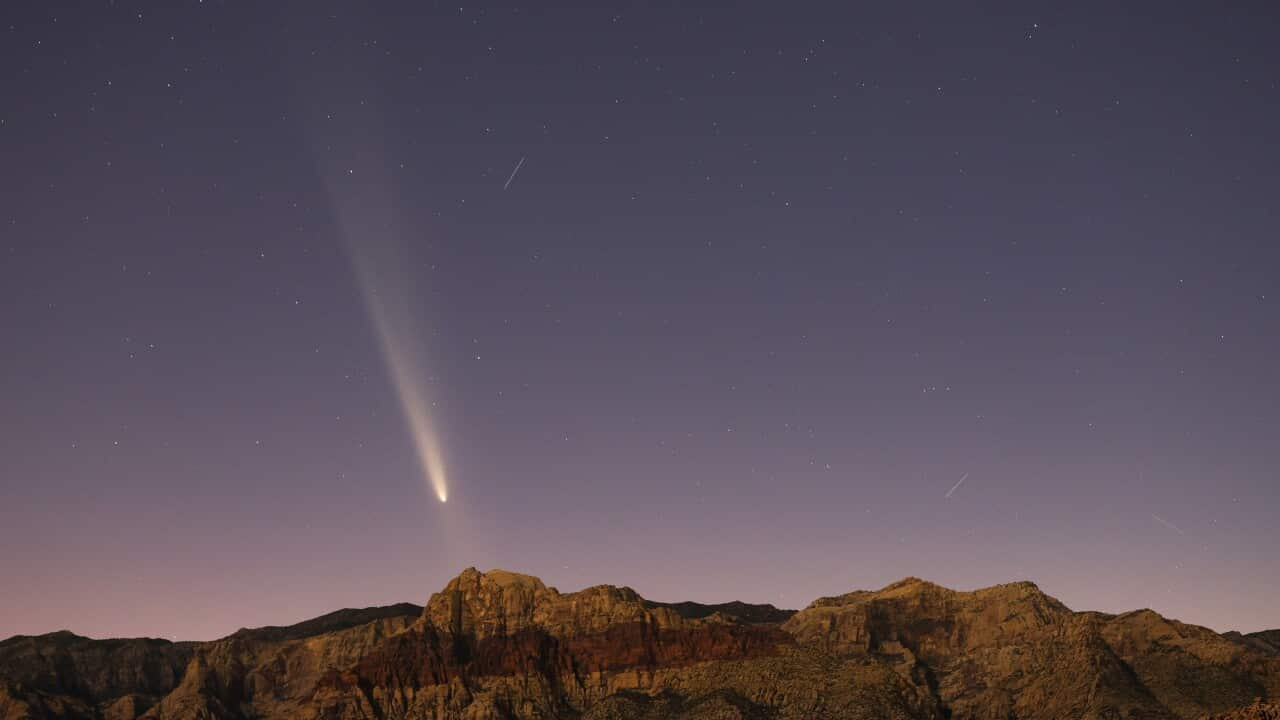Key Points
- Over the past week, the Tsuchinshan-ATLAS comet has been captivating observers in the Northern Hemisphere.
- Now, Australians will get the chance to see the comet that hasn’t been visible in our skies for 80,000 years.
- After this week, the comet will not return to our skies, as its orbit is taking it out of the solar system forever.
Over the past week, comet C/2023 A3, also known as Tsuchinshan-ATLAS, has been captivating observers in the Northern Hemisphere, with stunning photos being shared widely on X.
If those images left you in awe, get ready — Australia is next in line to catch a glimpse.
But it’s your last chance to see brightest comet visible in over a decade before it orbits out of solar system.
Here’s when and where to catch the unique celestial activity:
Comet C/2023 A3 (Tsuchinshan-ATLAS) over the town of Gallipoli, Italy, earlier this month. Source: Getty / NurPhoto
What is comet C/2023 A3? Why does it have two names?
Comet C/2023 A3 is a non-periodic comet, which means it doesn’t follow a regular orbit around the Sun and can take thousands or even millions of years to complete one journey through the solar system.
Non-periodic comets often originate from the Oort Cloud, a vast and distant region of icy bodies surrounding our solar system.
It was discovered in 2023 by both the Purple Mountain Observatory (Zijinshan Astronomical Observatory) in China and the Asteroid Terrestrial-impact Last Alert System (ATLAS) in South Africa almost simultaneously, which is why it is referred to by both names.
“The nucleus of this comet is a lump of rock, dust and ice in orbit around the Sun,” said observational astronomer professor Michael Brown from Monash University.
“When it approaches the Sun, the comet is heated and releases gas and dust, producing tails stretching millions of kilometres across space.”
Despite travelling at speeds of tens of kilometres per second, we can’t see the comet’s movement because it’s millions of kilometres from Earth.
Why is the Tsuchinshan-ATLAS comet special?
Brown said Tsuchinshan-ATLAS offers a unique opportunity to glimpse a relic from the formation of our solar system, dating back about 4.5 billion years.
“It’s definitely worth having a look. Hopefully, you’ll witness something memorable — a celestial visitor that hasn’t passed through our part of the solar system for 80,000 years,” Brown told SBS News, adding that this comet will not return to our skies, as its orbit is taking it out of the solar system forever.
was “considerably fainter” and not “nearly as interesting as this one”, Brown said.
The Devil Comet, officially known as 12P/Pons-Brooks, is a periodic comet that completes an orbit around the Sun every 71 years. Source: Getty / Marcos del Mazo
When is the best time to see the comet?
It has been visible in the northern hemisphere over the past week, and it’s not too late for Australia — though you may need to hurry.
Brown said the best time to see the comet with the naked eye is before this Sunday.
While it will still be visible after Sunday, it will be faint and will likely be seen only with binoculars for the rest of October and into early November.
After that, you’ll need a telescope to see it.
“The sooner you look for the comet, the better because it is fading and moving away from the sun,” Brown said.
He said an hour or so after sunset was the best time to look for the comet.
The comet Tsuchinshan-ATLAS (C/2023 A3) is seen over Torre Squillace, near Lecce, Italy, in October 2024. Source: Getty / NurPhoto
How to spot the Tsuchinshan-ATLAS comet
Brown said the ideal location for comet-gazers is somewhere dark with a clear view of the western horizon.
While he recommends staying away from bright lights for an optimal view, he said you can still see the comet from the city.
With the bright planet Venus currently visible in Australia, Brown suggests looking to the upper right of Venus to find the comet.
He said there were several free astronomy apps available to help in locating the comet.
“Comets don’t come by that often. They can be quite beautiful and there’s a chance to see it over the next few nights. So it’s a good opportunity to take a look.”



